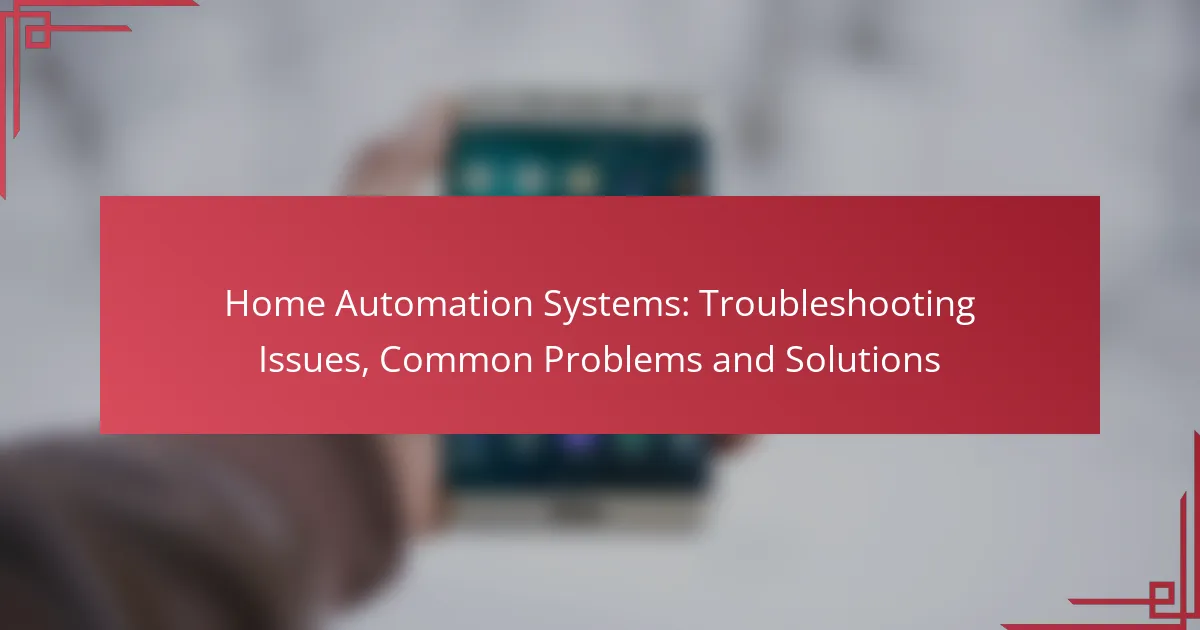Home automation systems can greatly enhance convenience and efficiency in modern living, but they are not without their challenges. Common issues such as connectivity problems, device compatibility, and software glitches can disrupt the seamless experience homeowners expect. By understanding these typical problems and their solutions, users can effectively troubleshoot and maintain their smart home systems.
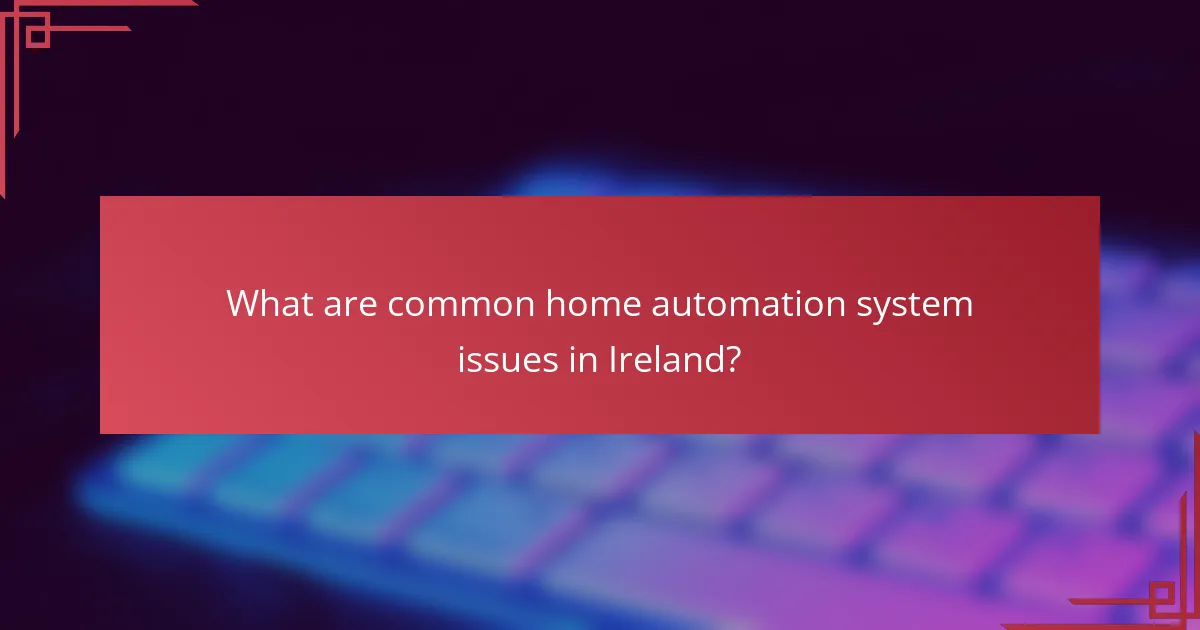
What are common home automation system issues in Ireland?
Home automation systems in Ireland often face issues such as connectivity problems, device compatibility challenges, software glitches, power supply failures, and sensor malfunctions. Understanding these common problems can help homeowners troubleshoot effectively and maintain a seamless smart home experience.
Connectivity problems
Connectivity problems are frequent in home automation systems, often caused by weak Wi-Fi signals or interference from other devices. To improve connectivity, ensure that your router is centrally located and consider using Wi-Fi extenders if necessary.
Check for firmware updates on your devices, as manufacturers often release patches that enhance connectivity. Additionally, using a wired connection for critical devices can significantly reduce connectivity issues.
Device compatibility issues
Device compatibility issues arise when different brands or models of smart devices fail to communicate effectively. This can happen due to varying protocols, such as Zigbee or Z-Wave, which may not be supported across all devices.
Before purchasing new devices, verify their compatibility with your existing system. Using a central hub that supports multiple protocols can help mitigate compatibility problems and streamline device integration.
Software glitches
Software glitches can disrupt the functionality of home automation systems, leading to unresponsive devices or unexpected behavior. Regularly updating the software on your devices is crucial to minimize these glitches.
If you encounter persistent issues, consider performing a factory reset on the affected devices. This can often resolve software-related problems, but be sure to back up your settings first to avoid losing your configurations.
Power supply failures
Power supply failures can cause devices to stop working altogether, often due to faulty power adapters or issues with electrical outlets. Ensure that all devices are plugged into functioning outlets and check for any visible damage to power cables.
Using surge protectors can help safeguard your devices against power surges, which can lead to failures. If a device frequently loses power, consider consulting a professional electrician to assess your home’s electrical system.
Sensor malfunctions
Sensor malfunctions can lead to inaccurate readings or failure to trigger actions, impacting the overall efficiency of your home automation system. Common causes include dirt or obstructions on the sensors, which can interfere with their operation.
Regularly clean and maintain your sensors to ensure optimal performance. If issues persist, check the device settings and consider recalibrating the sensors or replacing them if they are consistently unreliable.
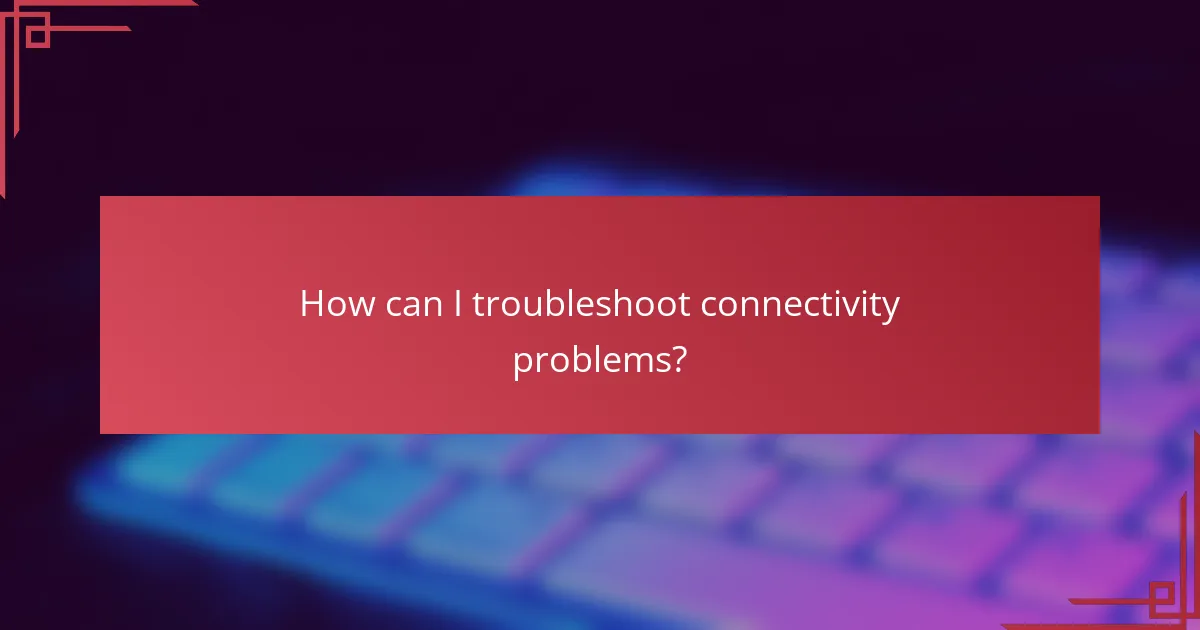
How can I troubleshoot connectivity problems?
Troubleshooting connectivity problems in home automation systems often involves checking network settings and device compatibility. Start by ensuring that your devices are within range of your Wi-Fi network and that there are no physical obstructions affecting the signal.
Check Wi-Fi signal strength
Wi-Fi signal strength is crucial for the performance of your home automation devices. Use a smartphone or a dedicated app to measure the signal strength in different areas of your home. Ideally, you want a signal strength of at least -70 dBm for stable connections.
If the signal is weak, consider relocating your router to a more central location or using Wi-Fi extenders to boost coverage. Avoid placing the router near thick walls or electronic devices that may cause interference.
Restart the router
Restarting your router can resolve many connectivity issues by refreshing the network connection. To do this, simply unplug the router, wait for about 10 seconds, and then plug it back in. This process typically takes just a few minutes.
After restarting, check if your home automation devices reconnect automatically. If not, you may need to manually reconnect them to the network. Regularly restarting your router can help maintain optimal performance.
Update firmware
Keeping your router’s firmware up to date is essential for security and performance. Manufacturers often release updates to fix bugs and improve compatibility with new devices. Check your router’s settings interface for any available updates.
To update, log into your router’s admin panel, usually accessible via a web browser. Follow the manufacturer’s instructions to download and install the latest firmware. Regular updates can prevent connectivity issues and enhance the overall functionality of your home automation system.

What are the solutions for device compatibility issues?
To resolve device compatibility issues in home automation systems, ensure that all devices are designed to work together seamlessly. This often involves using compatible devices, updating software, and following manufacturer guidelines.
Use compatible devices
Choosing devices that are specifically designed to work with your home automation system is crucial. Look for products that support the same communication protocols, such as Z-Wave, Zigbee, or Wi-Fi. For example, if your hub supports Z-Wave, ensure all connected devices are Z-Wave compatible.
Additionally, consider using products from the same manufacturer, as they are often engineered to integrate smoothly. This can reduce the chances of encountering compatibility issues and provide a more reliable user experience.
Update device software
Regularly updating the software of your home automation devices can resolve many compatibility issues. Manufacturers frequently release updates that improve functionality, fix bugs, and enhance security. Check for updates in the device’s app or web interface and install them as needed.
It’s also advisable to keep your central hub’s software up to date, as this can affect the performance of all connected devices. Set reminders to check for updates at least once a month to ensure optimal compatibility.
Check manufacturer guidelines
Each device comes with specific manufacturer guidelines that detail compatibility requirements. Review these documents to understand which devices can be paired together and any limitations that may exist. This information can often be found on the manufacturer’s website or in the product packaging.
Pay attention to any recommended configurations or settings that may enhance compatibility. Following these guidelines can prevent many common issues and ensure a smoother integration of your home automation system.
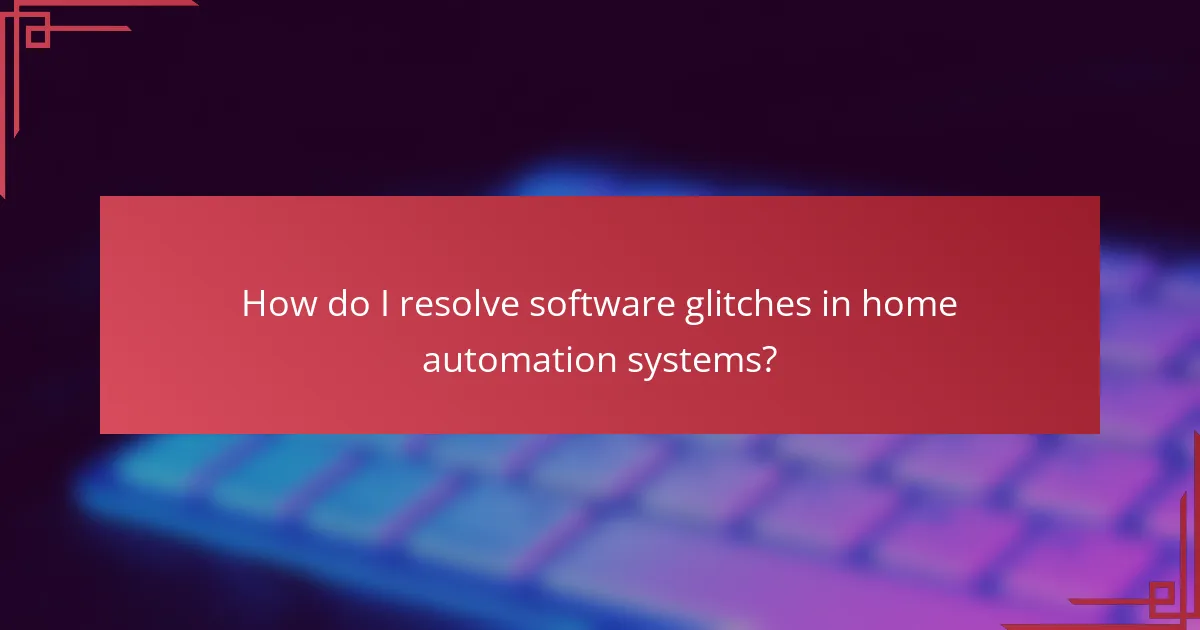
How do I resolve software glitches in home automation systems?
To resolve software glitches in home automation systems, start by identifying the specific issue and applying straightforward troubleshooting steps. Common solutions include rebooting the system, resetting to factory settings, or reinstalling the application.
Reboot the system
Rebooting your home automation system is often the quickest way to resolve minor software glitches. This process clears temporary data and can restore functionality without significant disruption.
To reboot, simply turn off the main hub or controller, wait for about 10-30 seconds, and then turn it back on. This can often resolve connectivity issues or unresponsive devices.
Reset to factory settings
If rebooting does not solve the problem, consider resetting the system to factory settings. This action restores the original configuration, which can help eliminate persistent software issues.
Before proceeding, back up any important settings or configurations, as this process will erase all customizations. Follow the manufacturer’s instructions for your specific device, as the reset method can vary.
Reinstall the application
Reinstalling the application associated with your home automation system can also help fix software glitches. This process removes any corrupted files and ensures you have the latest version of the software.
To reinstall, first uninstall the app from your device, then download it again from the appropriate app store. Make sure to check for updates after reinstalling to ensure optimal performance.
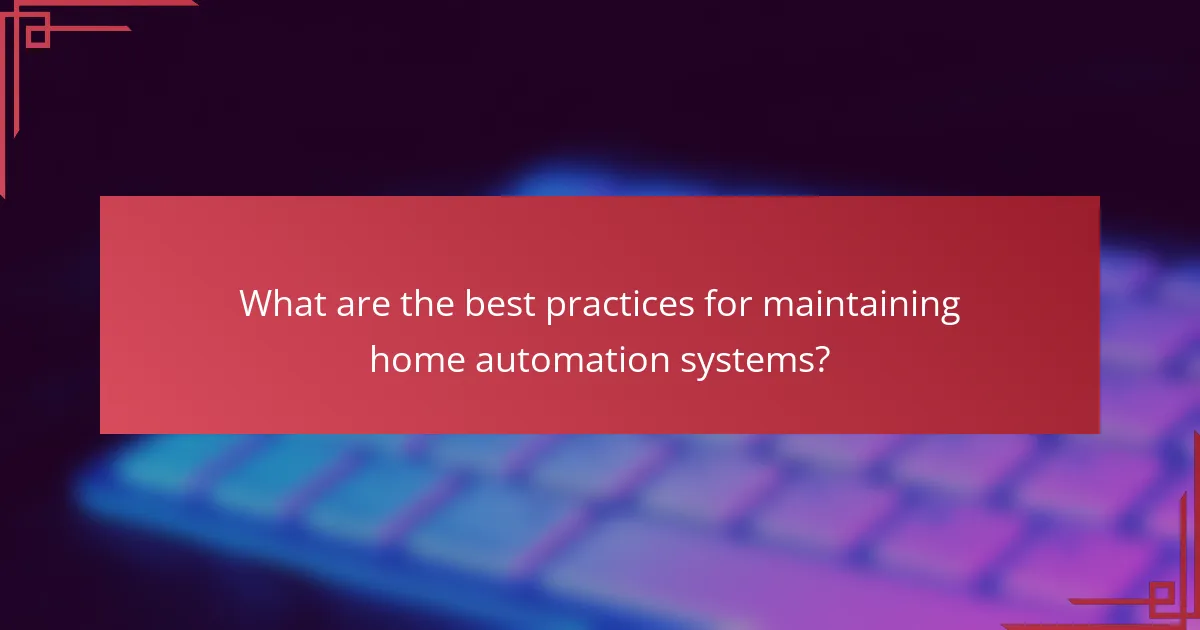
What are the best practices for maintaining home automation systems?
Maintaining home automation systems involves regular updates, routine checks, and secure configurations to ensure optimal performance and security. Following these best practices can help prevent common issues and prolong the lifespan of your devices.
Regular software updates
Keeping your home automation system’s software up to date is crucial for security and functionality. Manufacturers often release updates that fix bugs, enhance features, and patch vulnerabilities.
Set a schedule to check for updates at least once a month. Many systems allow automatic updates, which can simplify this process. However, ensure to review release notes to understand what changes are being made.
Routine device checks
Conducting routine checks on your devices helps identify potential issues before they escalate. Regularly inspect connections, batteries, and device performance to ensure everything operates smoothly.
Consider creating a checklist for your devices, including items like checking battery levels, ensuring firmware is current, and verifying that all components communicate effectively. This can be done quarterly or bi-annually, depending on usage.
Secure network configuration
Securing your network is essential for protecting your home automation system from unauthorized access. Use strong, unique passwords for your devices and Wi-Fi network, and enable encryption protocols like WPA3.
Regularly review your network settings and connected devices. Consider setting up a separate network for your smart devices to minimize exposure to potential threats. Additionally, disable features like remote access if they are not needed.

What should I consider when selecting a home automation system?
When selecting a home automation system, consider compatibility with existing devices, ease of use, and the range of features offered. It’s essential to evaluate your specific needs and the system’s ability to integrate with various smart home products.
Compatibility with existing devices
Ensure the home automation system you choose can seamlessly connect with your current devices, such as smart lights, thermostats, and security cameras. Look for systems that support popular protocols like Zigbee, Z-Wave, or Wi-Fi to maximize compatibility.
Check if the system is compatible with major platforms like Amazon Alexa, Google Assistant, or Apple HomeKit. This will allow for voice control and integration with other smart devices, enhancing your overall experience.
Ease of use
The user interface should be intuitive and easy to navigate. A complicated setup process can lead to frustration, so opt for systems that offer straightforward installation and user-friendly apps.
Consider systems that provide clear instructions and customer support. A responsive help center can be invaluable if you encounter issues during setup or operation.
Range of features
Evaluate the features offered by different home automation systems, such as remote access, automation routines, and security monitoring. Some systems allow for advanced scheduling and geofencing, which can enhance convenience and security.
Compare the pricing of systems with similar features. While more expensive options may offer advanced capabilities, ensure they align with your specific requirements and budget.
Scalability
Choose a home automation system that can grow with your needs. Scalability is crucial if you plan to add more devices or features in the future. Look for systems that allow for easy integration of additional components.
Consider whether the system supports third-party devices, as this can significantly expand your options for future upgrades without being locked into a single brand.
Security and privacy
Security is a top concern with home automation systems. Ensure the system you select has strong encryption protocols and regular software updates to protect against vulnerabilities.
Review the privacy policies of the system providers. Understand how your data will be used and stored, and choose systems that prioritize user privacy and data protection.
